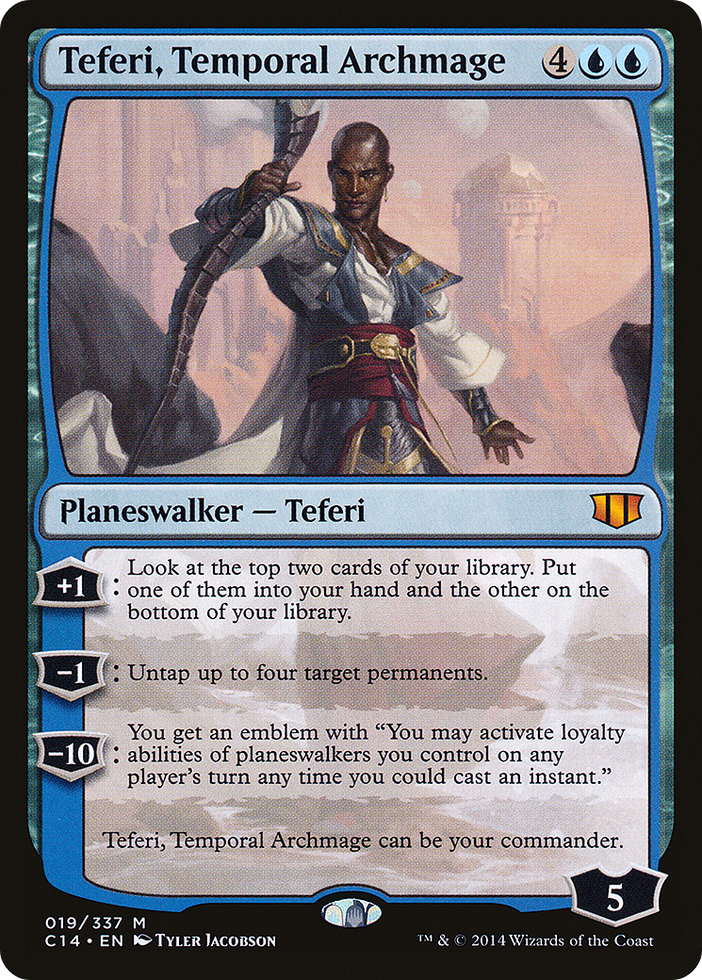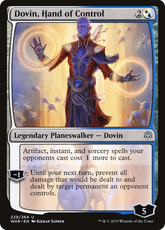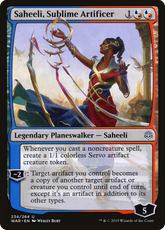The Planeswalker Debate
- PDH Home Base

- Oct 8, 2019
- 8 min read

Between War of the Spark and Core Set 2020, there are now 21 new uncommon planeswalkers, and the swell of planeswalkers in War prompted a debate within the EDH community about their legality as commanders. While this didn't result in any EDH rules changes, it did generate quite a bit of new interest in Oathbreaker. In less than 2 months, the number of subscribers on the oathbreaker subreddit went from around 1,000 to more than 7,000. Some of the hype and debate also made its way into the Pauper EDH community, with many voicing the question of whether or not the uncommon planeswalkers should officially be allowed as commanders. The issue was discussed on the PDH Home Base Discord, the Facebook page. The official response from the Home Base team was much the same as the response of the larger EDH community and EDH rules committee: planeswalkers are not officially allowed as commanders unless they have the “can be your commander” text (like on Teferi, Temporal Archmage), but individual play groups may use whatever house rules they like, including allowing planeswalkers as commanders. As is normal for online communities, everyone wanted the question to be resolved as soon as possible, and there was pressure on the Home Base team to rush out a response immediately. Now, however, we have had much more time to examine the cards and think through the potential impacts. This article is meant to pull all of the discussion points together in one place, so that the community and future players can better understand why the Rules Committee made the decision it did and why that decision is not being reversed any time soon.
I see two main points in favor of planeswalker commanders, two main points against, and several other arguments that could be positive or negative, depending on personal opinion. The new commanders would increase commander variety and help negate some of the most powerful effects currently dominating the format. However, they also have the potential to require more bans in the future because of power creep, and to strengthen blue when compared to other colors.
Increased Variety

Naturally, dumping 21 new commanders into our card pool would give us some fun new options to work with, as that’s almost half the number of uncommon creatures we usually get in a new standard-legal set. Among those, we have some great additions that would bolster several less common archetypes.
Davriel, Rogue Shadowmage would bolster discard control, giving the archetype a much needed win condition once opponents have been stripped of their hand and board state.
Dovin, Hand of Control would be the only cost-increasing effect in all of PDH that affects un-targeted spells. Dovin could even lead the first real PDH stax deck when combined with other taxing cards like Fade Away, Aura Flux, Disruptive Pitmage, Rhystic Deluge, and Soul Barrier.
Jaya, Venerated Firemage, when combined with pinging creatures like Prodigal Pyromancer, stands to give mono-red control much more staying power against large creatures.
Nahiri, Storm of Stone could provide Boros with its most flexible commander yet, blurring the lines between agro, tempo, and control by both quickly suiting up large threats and also removing problematic blockers.
Saheeli, Sublime Artificer could pilot one of the only enchantment-focused builds to not include white or green.
As a side note, I know many people probably cringe at the mentioning of stax, but I don't think a Dovin stax deck would be overly powerful or oppressive. Common rarity stax and tax cards tend to take the form of tempo plays and board state disruption, rather than the long term lockdowns that cause so much frustration in other formats.
More Power for Blue
With the War of the Spark planeswalkers, there is some potential for strengthening blue more than the other colors. Our format has a history of frustration with blue and its card advantage. I can offer quite a few counter arguments and strategies, and others on this site have written excellent articles doing just that, but the feeling of frustration still remains for many players. Recent sets have given other colors much better card advantage of their own, but the uncommon planeswalkers don’t reflect that shift. Instead, they seem to go back to the old maxim that only blue gets card advantage. Narset, Parter of Veils even goes as far as to shut down many cantrips, like Shoulder to Shoulder, which have long been one of the few sources of card advantage in non-blue decks. However, the main danger I see is that blue has far more access to proliferation than any other color, with Thrummingbird and Guildpact Informant being the only single cards that allow for repeatable proliferation. This proliferation could keep chip damage from small fliers from killing planeswalkers or allow them to repeatedly use their minus abilities for infinite value. Proliferation, when combined with Dovin’s ability to stop damage from a key creature, Saheeli’s creation of chump blockers without sacrificing loyalty, or Kiora, Behemoth Beckoner’s extremely high starting loyalty will make removing blue planeswalkers nearly impossible for some decks. For example, mono-black control, which has almost no way to destroy planeswalkers outside of combat.
Better Counterplay
Several of the new planeswalkers could act as hate pieces, shutting down some effects that are running rampant right now. For example, Ashiok, Dream Render can help slow or shut down graveyard play, which takes many forms, from the dominance of the drake combo, to the power of black repeatable recursion. While Relic of Progenitus and Tormod’s Crypt are great and widely used, a singleton format can’t depend on only two cards for 95% of its grave hate. One of the problems that has led to this reliance on Relic is the fact that there are almost no commanders with built-in grave hate. Nezumi Graverobber is just about the only current usable commander with grave hate, but it is mana intensive and can only hit creatures after it's flipped. Having more commanders with built-in grave hate floating around the format would drastically increase the likelihood of grave dependent decks encountering hate on a regular basis. Afterall, even decks packing Relic won’t draw it every time they need it.
The other types of hate effects on the uncommon planeswalkers tend to be even more unique in our format.
Ashiok also shuts down the tutors that often enable combo decks to find their pieces.
Dovin, Hand of Control stops combos that rely on infinitely recasting spells (like the Banishing Knack combo).
Narset, Parter of Veils and Ob Nixilis, the Hate-Twisted completely turn off infinite combo outlets that rely on drawing through the deck.
Teyo, the Shieldmage and The Wanderer block some ways that infinite mana combos kill, like Fireball.
Kasmina, Enigmatic Mentor greatly slows down removal-heavy control decks and could also weaken combo decks that rely on one or two pieces of removal to buy time.
Tibalt, Rakish Instigator disables several of the best of white and black decks, which require life gain to function.
Last, but certainly not least, Kaya, Bane of the Dead gives us the ultimate kill switch for hexproof voltron threats. This last one excites me more than any other. I firmly believe every strategy needs counterplay, but hexproof commanders are almost unstoppable, outside of enchantment wipes and edicts.
So to sum all of that up, we would gain counterplay against tutors, some infinite combos, spell and creature recursion, and hexproof voltron, all of which are among the most powerful strategies in the format.
Potential Power Creep
Wizards has a history with pushing the power of planeswalkers to the limit. In Legacy, Jace, the Mind Sculptor was banned for a long time and Wrenn and Six is currently making big waves. In Standard, Teferi, Hero of Dominaria and Teferi, Time Raveler have been frustrating many players over the last year and a half. Planeswalkers’ potential to be one-card, no cost value engines is very dangerous for our format because they could be far faster than the repeatable engines we usually seen in PDH. Right now, Chandra, Novice Pyromancer is the only uncommon planeswalker that can generate its own loyalty without help from proliferation. Because of her aggressive abilities, color identity, and tribal limitations, she shouldn't be overpowered or that difficult to kill, but she does show that Wizards is willing to create more walkers with loyalty generating abilities at uncommon rarity. In the recent State of Design article for 2019, Mark Rosewater said that he thought Wizards needed to be more careful about static abilities on uncommon walkers in the future. He also states that he thinks the design team is doing well by "upping the amount of complexity we allow at uncommon." These comments make it sound like there will definitely be more planeswalkers printed at uncommon that can generate their own loyalty. If these planeswalkers become a semi-frequent occurrence and are allowed as commanders, it is only a matter of time before we see some that are more consistent and powerful than the current top tier powerhouses, like Satyr Enchanter or Crackling Drake.
On the upside, if some planeswalkers are too powerful, the Rules Committee can always ban the problematic ones. However, that should be treated as a last resort, not as a reason or excuse to introduce dangerously powerful cards into the format. After all, by the time it's clear a ban is necessary, there are already a lot of unhappy players and lopsided games.
Preference-Based Arguments
There are several smaller arguments that come down to personal preference. The first two seem neutral, but the rest are against allowing planeswalkers as commanders.
Planeswalkers that focus on control, like Dovin, Davriel, and Ob Nixilis, could slightly decrease the creature-focus of the format. I think this will be a very minor shift, though, especially since there are already a good number of existing control and spell slinging decks and commanders.
Oathbreaker's rapid growth shows there is great interest in planeswalkers as commanders. However, there are also a decent amount of players that enjoy pauper and PDH precisely because they are the only formats that don't have planeswalkers. This can make these formats feel slightly more similar to playing Magic before planeswalkers were introduced, appealing to some players' feelings of nostalgia.
More differences between EDH and PDH rules could make it a little harder to get current EDH players to try PDH. On the other hand, more differences could also make PDH even more distinct as a separate format from EDH.
Many players would see adding planeswalkers as fundamentally changing the flavor of the format, and therefore see the change as undesirable. However, some people also see the distinction between creatures and planeswalkers as an arbitrary line in the sand.
Making a major change to one of the main rules of the format could confuse new players that see old posts and discussions. This could discourage new players if it makes them feel like the rules change too much or aren't well established. Good communication and heavy involvement with the online community would greatly mitigate this problem, but wouldn’t eliminate it entirely.
Another issue that could cause confusion is if planeswalkers are legalized as official commanders, then a new uncommon planeswalker is printed with the “can be your commander” text. Once again, this would mainly be an issue that comes up for newer players, which could slow the growth of the format.
Conclusion
That just about sums up all the arguments I have heard. In my opinion, most of the more impactful arguments for planeswalker being legalized are based around observation of the existing planeswalker cards and their direct interaction, and most of the major arguments against are based around speculative meta shifts and potential new cards in the future. Meanwhile, most of the preference-based points are focused on out-of-game elements, like flavor, nostalgia, and community growth.
Currently, there is no talk of the Rules Committee reversing its initial ruling, so planeswalkers will not be legal as official PDH commanders. However, this discussion is still important because the topic will be brought up again and again as players try out and enjoy decks with unofficial commanders. When the question is asked again in the future, hopefully this article helps explain our reasoning, show how seriously the decision was taken, and show that no voice in the community was ignored. This was not an arbitrary line drawn in the sand, but a careful weighing of potential impacts.
My personal opinion is that maintaining a strong resemblance to the EDH rules is important, at least until PDH is well recognized on its own in the larger sphere of Magic discourse. There are a lot of good changes that planeswalkers could cause in the format, but I don’t think it is worth the risk right now. Meanwhile, continuing to allow house rules to enable planeswalker commanders carries almost no risk.
What are your thoughts on this issue? Which arguments matter the most to you? Are there any points I missed?
- Paul (Scarecrow1779) @PDH_Homebase






































Comments